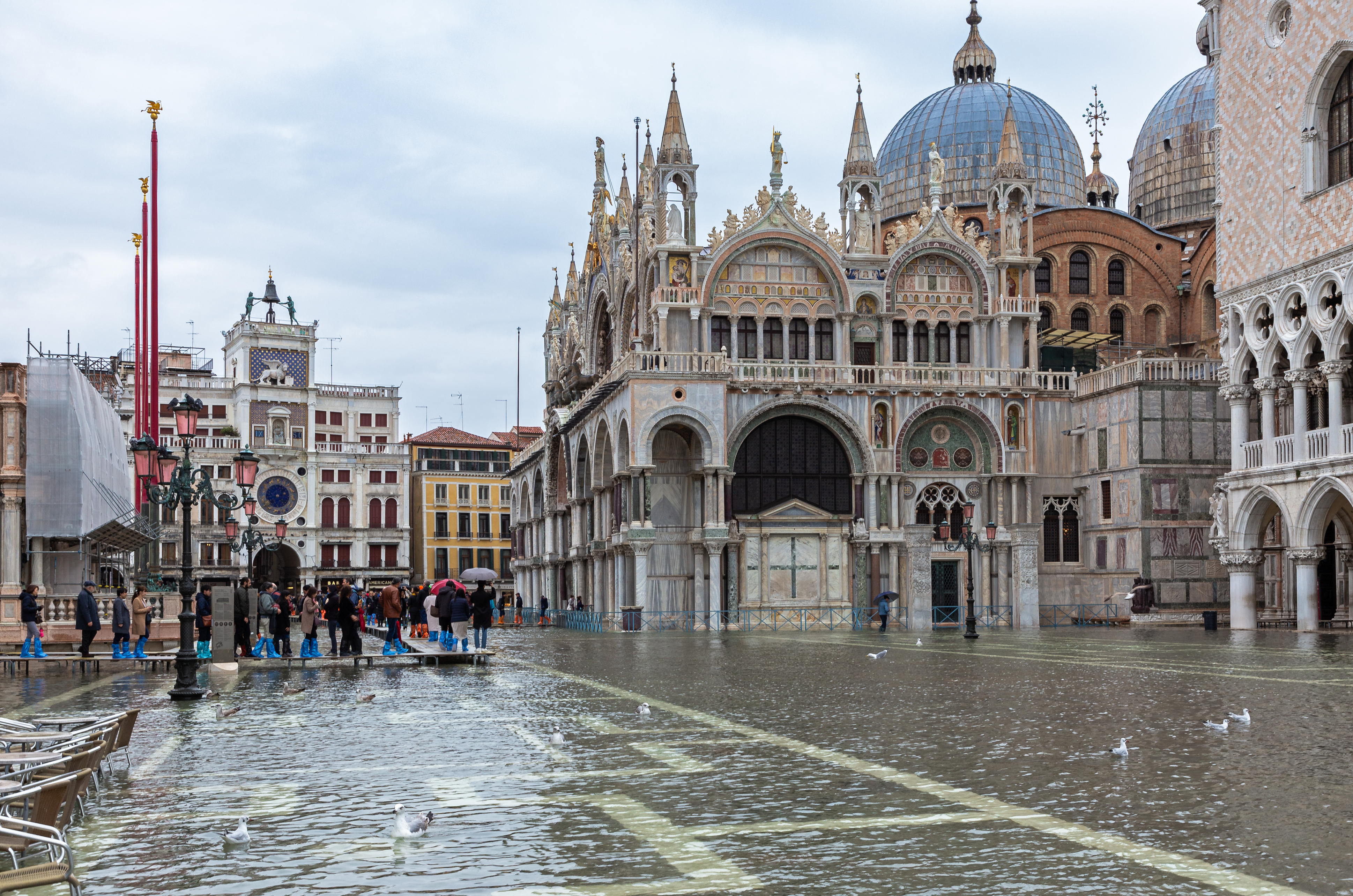In November 2019, 80 percent of the Italian city of Venice was underwater. The world-famous city is a maze of intertwined canals and sidewalks. While waterways have always been a part of the island city, tidal flooding events have temporarily flooded the cobblestone walkways and first floors of buildings more frequently in recent years. What are the short-term and long-term engineering options to keep Venice dry?
Venice is a city that bloomed on top of a sandbar. For nearly 2,000 years, people have lived on the cluster of islands that make up this commune. As the city grew, residents drove wooden piles through the sand and into the more stable clay below, allowing the islands to connect and grow into the lagoon (http://bit.ly/3K4ITe7). At its peak, the Republic of Venice was a seafarers’ empire that spread throughout the Adriatic and Mediterranean Seas.
Today, most of the city still sits on top of more than 60-foot piles. While these wood pilings would have fallen apart many times over if they were exposed to sunlight or even more oxygenated water, the sediment in the Venetian Lagoon helps protect the wood from oxygen and rot. Surprisingly, the wooden foundation of the city is not the most urgent infrastructure issue.
In the 1950s and 1960s, groundwater was pumped from underground aquifers below the city for industrial use. The city sank about 5 inches, which is significant when most of the city is barely above sea level to start with.
If you were in Venice today and a tidal flood was expected, you might see metal structures unfolding in the major walkways. The shortest-term solution to tidal flooding in Venice is low-tech. The city workers build temporary raised walkways throughout the city. Picture a bunch of metal banquet folding tables linked together to create a new sidewalk above a wet parking lot. Depending on the tide and winds, the walkways could be completely dry passages above puddles of water in low spots. Sometimes, the platforms offer an ankle-deep-water alternative to navigate the city instead of a waist-deep walk in a flooded piazza.
Protecting a sinking city
In 2019, a six-foot-tall human would have been underwater if their feet touched the ground in Piazza San Marco, the heart of Venice. This was not a normal tidal flood; many buildings had their entire first floor underwater, notes a Forbes article (http://bit.ly/3ImkwqQ). The temporary walkways were not enough.
The long-term fixes for this city are more complex than taller temporary walkways. How does Venice protect a sinking city from a rising ocean? MOSE (translating to experimental electromagnetic module system) is the answer, at least for now.
The $8 billion infrastructure project deploys a series of yellow sea barriers. These operable blocks are normally hidden beneath the surface of the ocean, allowing small boat traffic to pass over. When deployed, yellow boxes float up beyond the surface and create a physical flood barrier.
In Venice, 78 barriers form a dam separating the Venetian Lagoon from the Adriatic Sea. The barriers are split between four gates among the barrier islands that are the access points to Venice. When they are up, boat traffic is temporarily blocked for the lagoon. For a North American geography parallel, it would be like connecting all the islands that make up the Outer Banks of North Carolina into one continuous barrier. When MOSE is active, Venice is in more of a gigantic infinity pool than a bay or lagoon in the Adriatic.
The barriers that comprise the temporary dams are submerged tanks filled with water. When the tide is low, they stay flat below the surface of the water. When they activate the system, compressed air is pumped into the barriers and a top piece of the structure hinges up, resembling enormous pieces of cheese that form a line as they bob to the surface. They rise in modules but create a single water blockade when complete.
PBS has a great video that shows the system in action as a woman named Elisabetta Spitz manages the operation (www.youtube.com/watch?v=MFrZLbjlrRY).
Today, typical floods last fewer than four hours, so MOSE is usually hidden. If the Adriatic Sea level rises a foot, they may need to deploy MOSE every third or fourth day. How long will this system be viable? It depends on how fast the sea level rises and how slowly Venice sinks, which is hard to gauge.
Another option is to push Venice back up. When the aquifers were depleted by mining groundwater, the city sank. Is it possible to fill them back up? One long-term idea is to bore into the aquifers and pump in seawater. According to a Washington Post article (https://wapo.st/3E3AfbZ): “Such injections, performed at various boreholes that would be created throughout town, could raise Venice some [7 to 9 inches] — in effect wiping away 150 years of sinking and sea change, said Pietro Teatini, one of the hydraulic engineers behind the idea.”
The longest-term solution is a permanent wall, closing the Venetian Lagoon off from the sea. Essentially, the Venetian Lagoon would become a lake below the sea, similar to the levees that are used to keep New Orleans dry. For an empire built in the open ocean, serving as a maritime gateway to northern Italy, the identity of the region would inevitably change.
In many ways, Venice will be a proving ground for engineered systems that can help hold back the ocean. Cities such as New York and Miami could ultimately use similar techniques to reduce storm and tidal flooding impacts.
As anyone who has built a sand castle on the beach as the tide comes in knows, there is only so much you can do to hold back the ocean. Ideally, these technologies buy time for current generations to enjoy what exists. Hopefully, it does not encourage more people to move into areas that are on the razor edge of the sea.





